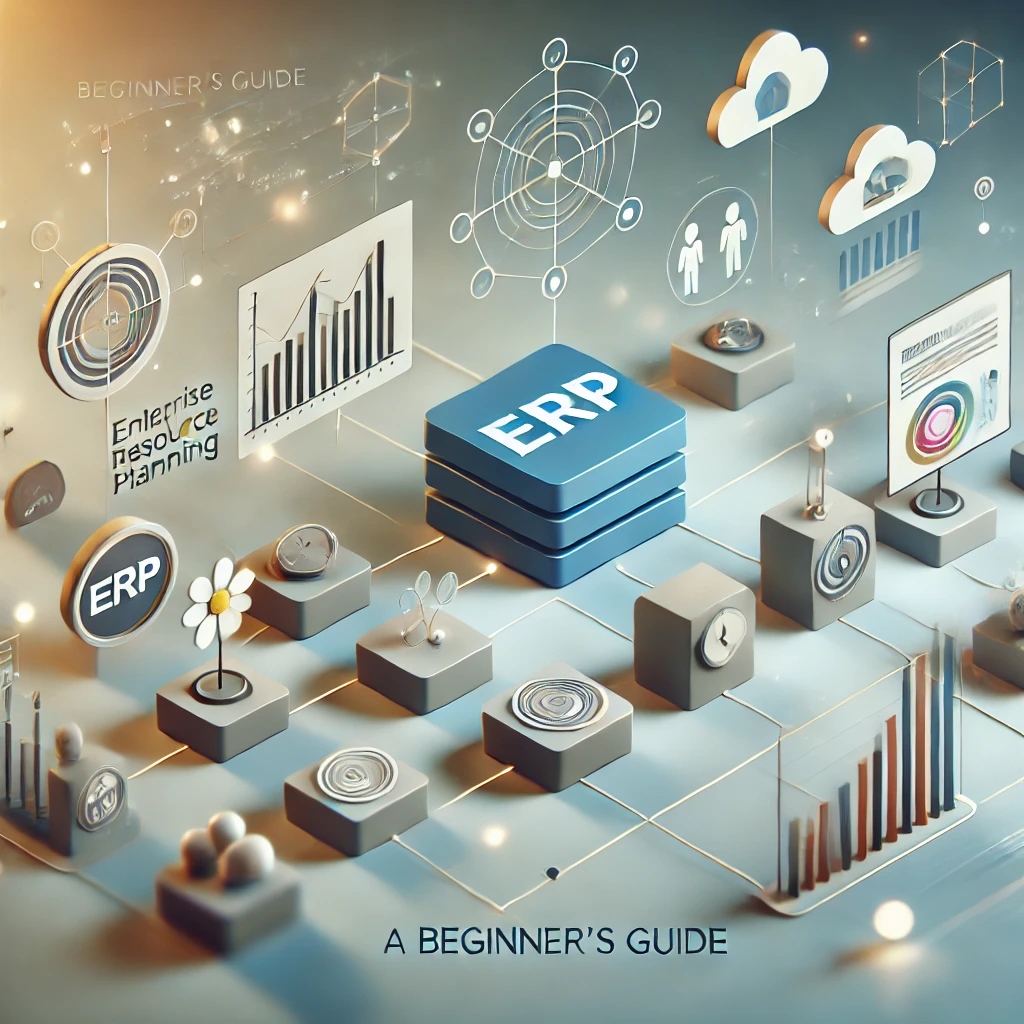ERP Insight: A Beginner's Guide 📙
 mahesh patil
mahesh patilTable of contents
- 1. What is ERP? 💻
- 2. Why Do You Need ERP? 🤔
- 3. Core Functions of ERP Systems 🛠️
- 4. Types of ERP Systems 💡
- 5. How Does ERP Help Your Business? 🤝
- 6. ERP Software Providers 💼
- 7. ERP Implementation: How to Get Started? 🚀
- 8. Common Myths About ERP 🔮
- 9. The Future of ERP 🌱
- 10. Conclusion 🏁: ** Is ERP Right for You?**

In today’s fast-paced business world, managing operations efficiently is crucial. One powerful tool that helps businesses do this is Enterprise Resource Planning (ERP). But what is ERP, and how can it benefit your business? Let’s dive in! 👇
1. What is ERP? 💻
ERP stands for Enterprise Resource Planning, a software system that helps businesses manage and integrate essential parts of their operations, such as finance, supply chain, inventory, manufacturing, and more.
These systems are crucial for improving efficiency, reducing operational costs, and ensuring that all departments within an organization are aligned and can communicate in one unified platform. 📊💻
2. Why Do You Need ERP? 🤔
Businesses of all sizes can benefit from ERP systems. Here’s why:
Centralized Data 📂: Keep all your data in one place.
Efficiency Boost ⚙️: Automate repetitive tasks and streamline business processes.
Real-Time Insights 📈: Get up-to-date reports and analytics to make faster, informed decisions.
Better Collaboration 💬: Improve communication across departments and teams.
3. Core Functions of ERP Systems 🛠️
ERP covers many areas of your business, including:
Finance and Accounting 💰: Manage budgets, financial reports, and transactions.
Human Resources (HR) 👥: Track employee information, payroll, and performance.
Inventory Management 📦: Keep tabs on stock levels, orders, and shipments.
Supply Chain Management 🚚: Manage suppliers, logistics, and production.
Sales and Customer Management (CRM) 🛍️: Track customer interactions, sales pipelines, and orders.
4. Types of ERP Systems 💡
There are three main types of ERP systems:
On-Premise ERP 🏢: Installed on your company’s hardware.
Cloud ERP ☁️: Hosted online, allowing for easier access and scalability.
Hybrid ERP 🔄: A combination of both on-premise and cloud solutions.
5. How Does ERP Help Your Business? 🤝
ERP systems offer several benefits:
Improved Productivity ⏳: Automate processes to save time.
Cost Efficiency 💸: Reduce operational costs and eliminate redundancy.
Better Decision-Making 🧠: Use real-time data and analytics for smarter choices.
Scalability 📈: As your business grows, your ERP system can grow with it.
6. ERP Software Providers 💼
SAP 🖥️ – A leading ERP software for large enterprises with a comprehensive set of tools.
Oracle ERP ☁️ – Cloud-based ERP solutions, popular for finance and operations management.
Microsoft Dynamics 365 💼 – A versatile ERP system that integrates with other Microsoft products.
Infor M3 ⚙️ – A highly customizable ERP system for industries like manufacturing and distribution.
NetSuite 🌐 – A cloud-based ERP that offers financial management, CRM, and eCommerce features.
Epicor 🔧 – ERP software focused on manufacturing, distribution, and retail industries.
Sage ERP 📊 – Provides tools for financial management and business intelligence.
| ERP Software Provider | Key Features | Industry Focus | Notable Strengths |
| SAP | Financial management, supply chain, HR | Manufacturing, Retail | Extensive integration, scalability, global reach |
| Oracle ERP Cloud | Financials, procurement, project management | Multiple industries | Advanced analytics, strong security |
| Infor M3 | Supply chain, manufacturing, retail | Manufacturing, Fashion | Industry-specific solutions, flexibility |
| Microsoft Dynamics 365 | Finance, sales, operations, HR | Various industries | Seamless integration with Microsoft tools |
| NetSuite | Financial management, CRM, eCommerce | SMBs, Retail | Strong financial capabilities, scalability |
| Epicor | Manufacturing, inventory management, HR | Manufacturing, Retail | Industry-specific, strong inventory management |
| Sage Intacct | Financial management, accounting | SMBs, Non-profits | Strong financial control, scalability |
🏢💼 SMBs stands for Small and Medium-sized Businesses.
7. ERP Implementation: How to Get Started? 🚀
Setting up an ERP system involves a few essential steps:
Step 1: Evaluate Your Needs 🔍: Identify which areas of your business require improvement.
Step 2: Choose the Right ERP ✅: Select a solution that fits your business needs.
Step 3: Plan the Implementation 📝: Outline the timeline, resources, and training required.
Step 4: Train Your Team 👩🏫: Make sure everyone is ready to use the new system.
Step 5: Go Live! 🎉: Launch your ERP system and start reaping the benefits.
8. Common Myths About ERP 🔮
Myth 1: ERP is Only for Large Companies 🚫: Small businesses can also benefit from ERP systems tailored to their size.
Myth 2: ERP is Too Expensive 💰: There are cost-effective ERP solutions, especially for small to medium-sized businesses.
Myth 3: ERP Systems are Too Complicated 🧐: Modern ERP systems are user-friendly and easy to adapt to.
9. The Future of ERP 🌱
ERP systems are constantly evolving. The future looks bright with:
AI Integration 🤖: Artificial Intelligence to automate tasks and provide insights.
Cloud-Based Solutions ☁️: More businesses are opting for flexible cloud-based ERP.
Data Analytics 📊: ERP systems are becoming more data-driven, helping businesses make smarter decisions.
10. Conclusion 🏁: ** Is ERP Right for You?**
If you’re looking to improve efficiency, enhance communication, and make better business decisions, then ERP might be the solution for you! Start small, do your research, and take your business to the next level. 🚀
Did you find this easy to understand? ✔️ Or Got questions ❓ Drop a comment! 💬😊
📌 In my next blog series, I will be focusing on Infor M3 ERP. Stay tuned 🔔
Subscribe to my newsletter
Read articles from mahesh patil directly inside your inbox. Subscribe to the newsletter, and don't miss out.
Written by
